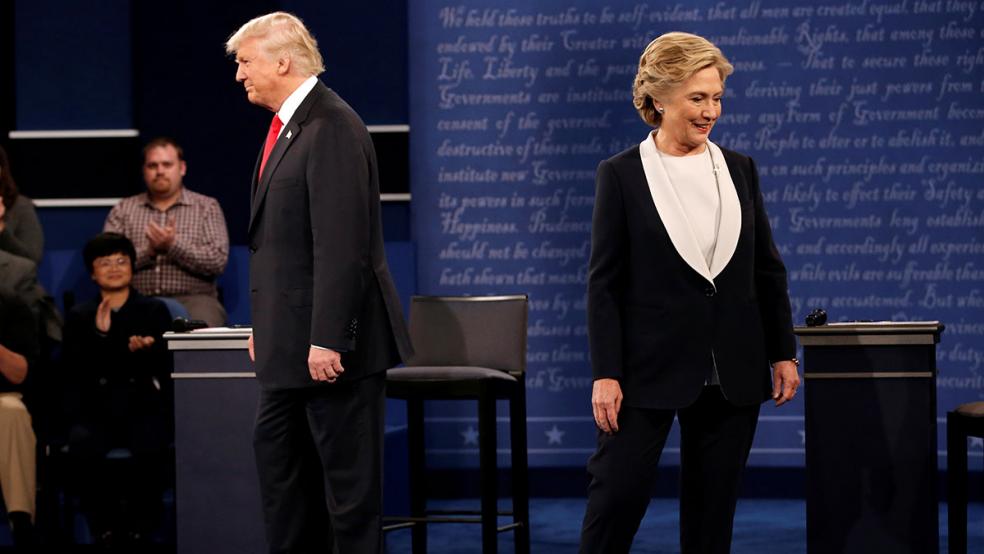Even though Gary Johnson sometimes exhibits goofy behavior and suffers from brain freezes, I will be voting for him on Election Day. His shortcomings do not worry me because I am certain he will lose.
A vote for Johnson or other third party candidates like Jill Stein or Evan McMullin is a vote for the long-term health of America’s political system. As I explained in a previous column, I am confident that my single vote won’t swing the election, so I might as well use my ballot strategically.
This election has witnessed a profound failure of the political market. A total of $1.8 billion has been spent to provide voters with two viable candidates, both of whose unfavorable ratings exceed 50 percent. Although economists normally apply the term “market failure” to private sector industries, David Friedman, the noted libertarian and professor of law at Santa Clara University, has aptly used the term to describe the electoral process.
Related: It Looks Like Investors Have a Clear Favorite in the Election
One cause of market failure is lack of competition. When a small number of firms control a particular market, they can raise prices and reduce production below efficient levels. In this election year, the political party duopoly has failed to produce an attractive candidate, instead offering two objectionable contenders at high donor cost.
The length and intensity of the election process also creates wider opportunity costs, diverting time and attention away from other concerns. As NPR reported last year, Canada, Mexico, the U.K. and Japan had recent election cycles ranging from 12 to 147 days, while in the U.S., the process is taking 596 days.
So how can we fix our broken political market? One option — pioneered over a century ago by Teddy Roosevelt and others — would be to break up the political parties. But it is exceedingly unlikely that the Justice Department, controlled by a political appointee, would unleash its Antitrust Division on the Democrats and Republicans. Further, breaking up the political parties could be ruled an unconstitutional violation of the First Amendment right to assemble.
Related: It's Time We Stop Banning Selfies at the Voting Booth
A more promising approach to ending the party duopoly involves elevating new competitors, like the Libertarians and Greens, into the fray. Right now, third parties have to overcome significant barriers to entry, which most often take the form of ballot-access laws.
Richard Winger, Editor of Ballot Access News, estimates that it would cost a new political party more than $6 million to get a presidential candidate onto all 50 state ballots., with most of the money needed to fund petition drives. For established third parties the cost is lower since they already have ballot status in some states, but the remaining seven-figure expense siphons away the relatively scarce resources available to these parties. One way voters can help third parties lower their ballot-access costs in future elections is to vote for them now.
The accompanying chart, reprinted from Ballot Access News, lists states in which presidential vote totals affect a third party’s ability to obtain ballot access. For example, in Colorado, if a third-party candidate receives 1 percent or more of presidential votes cast in the state, the party will be able to place its candidates on the 2018 and 2020 ballots without the need to circulate petitions.
| 2016 PRESIDENTIAL VOTE EFFECT ON PARTY QUALIFICATION OR RETENTION | |||
| State | Percent Needed | How Long Does Status Last? | Apply to All Offices? |
| Alabama | 20% | 2018 | yes |
| Alaska | 3% | 2020, but not 2018 | no, only president in 2020 |
| Arizona | 5% | 2018 and 2020 | yes |
| Arkansas | 3% | 2018 | yes |
| Colorado | 1% | 2018 and 2020 | yes |
| Connecticut | 1% | 2020, but not 2018 | no, only president in 2020 |
| D.C. | approximately 2.5% | 2018 | yes |
| Georgia | 20% in entire nation | 2018 and 2020 | yes |
| Georgia | approximately 1.5% | 2018 | no, only statewide offices |
| Hawaii | 10% | 2018 | yes |
| Idaho | 3% | 2018 | yes |
| Illinois | 5% | 2018 | no, only statewide offices |
| Iowa | 2% | 2018 | yes |
| Kansas | 1% | 2018 | yes |
| Kentucky | 2% | 2018, 2019, 2020 | yes |
| Louisiana | 5% | 2018, 2019, 2020 | yes |
| Maryland | 1% | 2018 | yes |
| Massachusetts | 3% | 2018 | yes |
| Michigan | approximately one-half % | 2018 | yes |
| Minnesota | 5% | 2018 and 2020 | yes |
| Missouri | 2% | 2018 and 2020 | yes |
| Montana | approximately 2% | 2018 and 2020 | yes |
| Nebraska | 5% | 2018 and 2020 | yes |
| Nevada | 1% | 2018 | yes |
| New Mexico | One-half % | 2018 | yes |
| No. Carolina | 2% | 2018 and 2020 | yes |
| No. Dakota | 5% | 2018 | yes |
| Ohio | 3% | 2018 and 2020 | yes |
| Oklahoma | 2.50% | 2018 | yes |
| Oregon | 1% | 2018 and 2020 | yes |
| Pennsylvania | approximately 1% | 2017 and 2018 | only special elections |
| Rhode Island | 5% | 2018 and 2020 | yes |
| Tennessee | 5% | 2018 | yes |
| Texas | 5% | 2018 | yes |
| Utah | 2% | 2018 and 2020 | yes |
| Virginia | 10% | 2017 and 2018 | Yes |
| Washington | 5% | 2018 and 2020 | yes |
| Wisconsin | 1% | 2018 | yes |
| SOURCE: BALLOT ACCESS NEWS | |||
Other states, like California, use vote totals in gubernatorial and other statewide races to determine ballot access.
Related: How Do You Get Millennials to the Polls? Maybe Puppies Will Help
John Oliver’s recent skewering of Gary Johnson and Jill Stein gave viewers numerous reasons to doubt whether either of these candidates is ready for prime time. But the fact that today’s third parties are nominating flawed candidates is not surprising given that these parties have no chance of winning. Serious candidates thus have no reason to seek third-party nominations and so the number and quality of possible choices for the Libertarians and Greens is naturally limited.
We are left with something of a chicken-and-egg situation: Third parties lack the gravitas to attract A-level candidates, and the B-level candidates they run don’t pass muster with media elites, thus limiting their ability to spread the party’s message and build support. One way to escape this negative feedback loop is for a bloc of voters to support third parties despite their candidates’ deficiencies.
Voting on this basis is like being an angel investor funding a start-up: The financier doesn’t really know whether the company is going to succeed but likes its concept enough to take a risk. Third-party voting is much less risky than angel investing because a single vote has almost no chance of changing an electoral outcome.
Related: An Algorithm With a Solid Track Record Is Predicting a Trump Win
Taking the Silicon Valley analogy a step further, one could imagine entrepreneurs starting a new non-ideological party using techniques akin to those employed by Uber and Airbnb to disrupt the political market, as Dave Maney recently suggested at The Daily Beast. But the 2012 experience of Americans Elect offers a cautionary tale about the prospects for such a strategy: The group ran an online presidential primary but no candidate reached its nominating threshold.
It may be the case that only billionaires like Ross Perot and ideological groups like the Greens and Libertarians can surmount the barriers to entry protecting the political market. Personality-based parties like Perot’s Reform Party have difficulty surviving once the founder loses interest, but ideological parties have access to a stream of volunteers as new generations of young people become inspired by the ideology.
By nominating two former governors, neither of whom is a true adherent to its ideology, the Libertarian Party has shown an interest in balancing purity with mainstream acceptability. Although Gary Johnson has proven to be an imperfect vessel for this hybrid approach, a vote for him in 2016 may enable the party to field stronger candidates in 2020 and beyond.






